Bycanistes
Bycanistes is a genus of medium to large, primarily frugivorous hornbills (family Bucerotidae) found in the forests and woodlands of Sub-Saharan Africa. They have often been included in the genus Ceratogymna, but today most authorities consider them separate. All species in this genus have black and white plumage. The plumage of the sexes is similar, but the casque of the male is larger than that of the female.
| Bycanistes | |
|---|---|
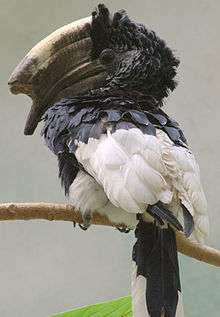 | |
| Black-and-white-casqued hornbill (Bycanistes subcylindricus) | |
| Scientific classification | |
| Kingdom: | Animalia |
| Phylum: | Chordata |
| Class: | Aves |
| Order: | Bucerotiformes |
| Family: | Bucerotidae |
| Genus: | Bycanistes Cabanis & Heine, 1860 |
| Species | |
|
5-6, see text. | |
Recent genetic data shows that Bycanistes is the sister taxon to ground hornbills, this clade having diverged from the rest of the hornbill lineage early on.[1] Bycanistes is thought to represent an early African lineage, while the remaining Bucerotiformes evolved in Asia.
Species
| Image | Scientific name | Common Name | Distribution |
|---|---|---|---|
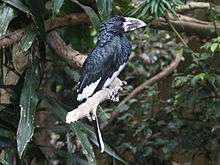 | Bycanistes fistulator | Piping hornbill | Senegal east to Uganda and south to Angola |
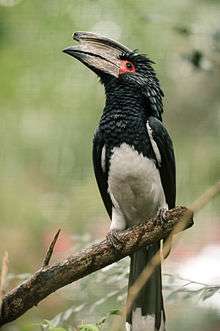 | Bycanistes bucinator | Trumpeter hornbill | Burundi, Mozambique, Botswana, Congo, Kenya, the Caprivi strip of Namibia and eastern South Africa |
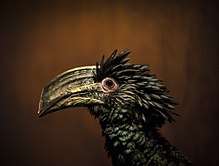 | Bycanistes cylindricus | Brown-cheeked hornbill | Ivory Coast, Ghana, Guinea, Liberia, Sierra Leone, and Togo |
| Bycanistes albotibialis | White-thighed hornbill | Angola, Benin, Cameroon, Central African Republic, Republic of the Congo, Democratic Republic of the Congo, Equatorial Guinea, Gabon, Nigeria, Sudan, and Uganda | |
 | Bycanistes subcylindricus | Black-and-white-casqued hornbill | western Kenya to Côte d'Ivoire with an isolated population in north Angola |
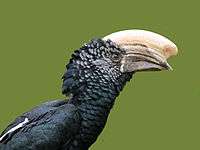 | Bycanistes brevis | Silvery-cheeked hornbill | forests of East Africa from Ethiopia to South Africa |
gollark: And would still require memorising a ton of metadata.
gollark: See, that would maybe be more secure, except for the physical book thing, but also extremely annoying.
gollark: I mostly use the built-in Firefox one. It's more secure and convenient than remembering passwords.
gollark: > Do you use a password management service or what?Yes. I also have other vaguely private stuff.
gollark: Or, well, I am worried about data loss but not because of this.
References
- Woodruff, D. S. & Srikwan, S. 2011. Molecular genetics and the conservation of hornbills in fragmented landscapes. In Poonswad, P. (ed) The Asian Hornbills: Ecology and Conservation. National Center for Genetic Engineering and Biotechnology, Bangkok, pp. 257-264.
- Kemp, A. C. (2001). "Family Bucerotidae (Hornbills)". pp. 436–523 in: del Hoyo, J., Elliott, A., & Sargatal, J. eds. (2001). Handbook of the Birds of the World. Vol. 6. Mousebirds to Hornbills. Lynx Edicions, Barcelona. ISBN 84-87334-30-X
This article is issued from Wikipedia. The text is licensed under Creative Commons - Attribution - Sharealike. Additional terms may apply for the media files.